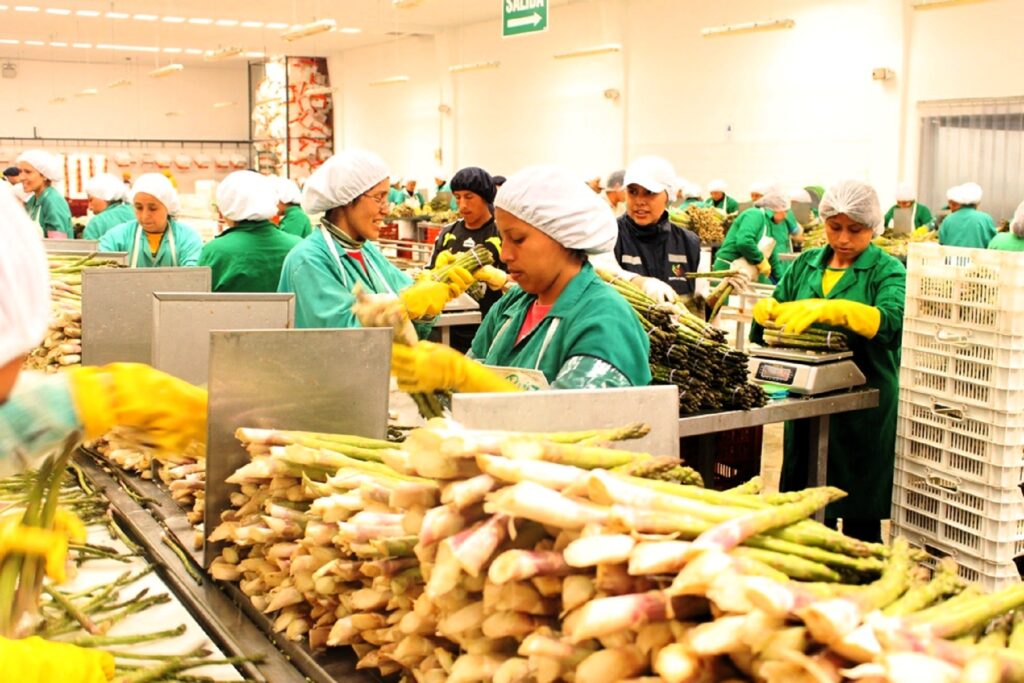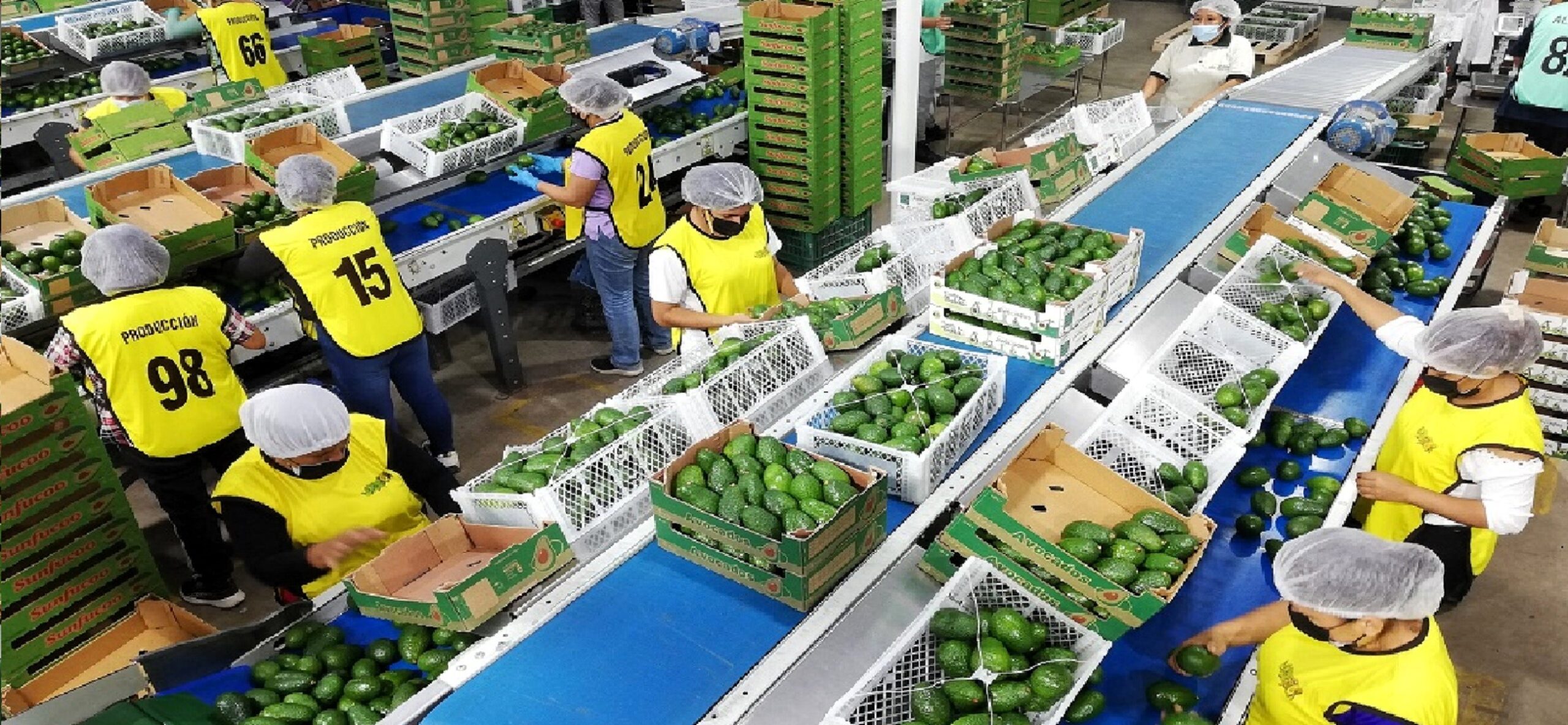Agencia Peruana de Noticias PRENSAPERU.PE https://prensaperu.pe/ Twitter: @prensaperupe Entre enero y noviembre del 2023, los despachos agrarios peruanos (tradicionales y no tradicionales) sumaron cerca de US$ 8 mil 822 millones y llegaron a 135 mercados, algunos recuperados como el Congo, Montenegro y Nueva Caledonia, indicó la Asociación de Exportadores (ADEX).
Desde hace años, EE.UU. se mantiene como el principal mercado (más del 30% del total) gracias al Acuerdo de Promoción Comercial suscrito con esa nación y vigente desde el 1° de febrero del 2009, es decir, hace casi 15 años.
En opinión de la gerenta de Agroexportaciones del gremio, Claudia Solano Oré, existe una tarea pendiente a fin de garantizar una oferta de calidad para el consumo interno y para que Perú mantenga su imagen de proveedor global confiable. En el 2022 estaba en el top ten de los países exportadores de arándanos, paltas, uvas y otros.
Indicó que una preocupación latente es el fenómeno de El Niño, que seguiría perjudicando el desenvolvimiento de los cultivos este año. “También se debe promover la diversificación de los mercados, no solo con el trabajo de Senasa, sino con actividades de prospección e identificación de más compradores”, expresó.
Precisamente, con el objetivo de potenciar estos despachos, que a noviembre representaron el 15.2% del total exportado por Perú, la Gerencia de Agroexportaciones de ADEX impulsará este año una serie de actividades como ferias, conferencias, misiones comerciales, convenciones y encuentros empresariales.
Algunas de ellas son el FDA Summit (marzo), la 22° edición del Almuerzo Agroexportador (abril), IV Ginger Week (junio), la IV Convención de Granos Andinos (julio), IV Cóctel de Cacao y Chocolate (julio), II Congreso Internacional de las Passifloras del Perú (agosto), el Encuentro Empresarial de Capsicum (septiembre), el Congreso internacional de inversión y transferencia agro tecnológica (noviembre).
ENVÍOS PRIMARIOS
Entre enero y noviembre del 2023 los envíos agrarios tradicionales (US$ 802 millones 181 mil), cayeron -35.5% en relación al mismo lapso del 2022. Su producto ‘estrella’ fue el café (US$ 699 millones 496 mil), pese a presentar una disminución de -39%. Otras partidas fueron demás azúcares de caña o remolacha refinados en estado sólido, y melaza de caña.
EE.UU. (US$ 221 millones 952 mil) se convirtió en el destino líder, pero descendió -27%; en segundo lugar estuvo Alemania (US$ 221 millones 952 mil) con una contracción de -47%. Completaron el top ten Bélgica, Canadá, Ecuador, Italia, Países Bajos, Colombia, Francia y Suecia. De este grupo, solo Ecuador cerró en azul (168.4%).
VALOR AGREGADO
Asimismo, las agroexportaciones no tradicionales ascendieron a poco más de US$ 8 mil 019 millones, logrando un alza de 7% y una concentración de 91% del total agro. Su producto principal fue el arándano fresco (casi US$ 1,378 millones) con un crecimiento de 13.4%, para esta primera etapa de la campaña 2023-2024 (inicia en agosto y culmina en marzo). También resaltaron las uvas, paltas, espárragos y mangos.
El mercado N° 1 fue EE.UU. (US$ 2 mil 790 millones) con un aumento de 6%. En el segundo puesto estuvo Países Bajos, el hub líder en Europa; luego se ubicaron España, Chile y Ecuador. Las 10 primeras posiciones la completaron Reino Unido, China, México, Colombia y Hong Kong.
ZONAS GEOGRÁFICAS
A nivel de zona geográfica, destacó la costa con agroexportaciones por US$ 5 mil 754 millones o 65.2% del valor total exportado), seguido por la zona Lima y Callao con US$ 2 mil 143 millones (24.3%), la andina con US$ 618 millones (7%) y la amazonía con US$ 307 millones (3.5%).
En la costa sobresalió La Libertad con US$ 1,771 millones, al concentrar el 20.1% del total agro. Los arándanos y la palta fueron sus productos líderes. Les siguió Ica (US$ 1,644 millones) con la uva y los arándanos como sus dos principales alimentos; y Piura (US$ 1,053 millones). Destacaron la uva y los mangos.
En la zona Andina resaltaron Cajamarca (US$ 314 millones) y Junín (US$ 211 millones), y en la Amazonía San Martín (US$ 185 millones).
En el periodo enero-noviembre del 2023, 6 de las 25 regiones del Perú tuvieron a la agroexportación como su principal sector: Piura, Lambayeque, San Martín, Ucayali, Amazonas y Huánuco.
MÁS INFORMACIÓN
Las agroexportaciones peruanas (tradicionales y no tradicionales) crecieron casi 1% entre enero y noviembre del 2023 respecto al mismo periodo del 2022.
Fuente: Agencia Peruana de Noticias PRENSAPERU.PE https://prensaperu.pe/ Twitter: @prensaperupe

English Translation
ADEX indicated that between January and November 2023, Peruvian agro-exportable supply reached 135 international destinations, both traditional and non-traditional.
Peruvian News Agency PRENSAPERU.PE https://prensaperu.pe/ Twitter: @prensaperupe Between January and November 2023, Peruvian agricultural dispatches (traditional and non-traditional) totaled nearly US$ 8,822 million and reached 135 markets , some recovered such as the Congo, Montenegro and New Caledonia, indicated the Association of Exporters (ADEX).
For years, the US has remained the main market (more than 30% of the total) thanks to the Trade Promotion Agreement signed with that nation and in force since February 1, 2009, that is, almost 15 years ago. .
In the opinion of the union’s Agroexports manager, Claudia Solano Oré, there is a pending task in order to guarantee a quality offer for domestic consumption and for Peru to maintain its image as a reliable global supplier. In 2022 it was in the top ten of exporting countries of blueberries, avocados, grapes and others.
He indicated that a latent concern is the El Niño phenomenon, which would continue to harm the development of crops this year. “The diversification of markets must also be promoted, not only with the work of Senasa, but with prospecting activities and identification of more buyers,” he said.
Precisely, with the objective of promoting these shipments, which as of November represented 15.2% of the total exported by Peru, the ADEX Agro-Export Management will promote this year a series of activities such as fairs, conferences, trade missions, conventions and business meetings.
Some of them are the FDA Summit (March), the 22nd edition of the Agro-Exporter Lunch (April), IV Ginger Week (June), the IV Andean Grains Convention (July), IV Cocoa and Chocolate Cocktail (July), II International Congress of the Passifloras of Peru (August), the Capsicum Business Meeting (September), the International Congress of investment and agro-technological transfer (November).
PRIMARY SHIPMENTS
Between January and November 2023, traditional agricultural shipments (US$ 802 million 181 thousand) fell -35.5% compared to the same period in 2022. Its ‘star’ product was coffee (US$ 699 million 496 thousand), despite present a decrease of -39%. Other items were other cane or beet sugars refined in solid state, and cane molasses.
The US (US$ 221 million 952 thousand) became the leading destination, but fell -27%; In second place was Germany (US$ 221 million 952 thousand) with a contraction of -47%. Belgium, Canada, Ecuador, Italy, Netherlands, Colombia, France and Sweden completed the top ten. Of this group, only Ecuador closed in blue (168.4%).
VALUE ADDED
Likewise, non-traditional agricultural exports amounted to just over US$ 8,019 million, achieving an increase of 7% and a concentration of 91% of the total agricultural exports. Its main product was fresh blueberries (almost US$ 1,378 million) with a growth of 13.4%, for this first stage of the 2023-2024 campaign (starts in August and ends in March). Grapes, avocados, asparagus and mangoes also stood out.
The No. 1 market was the US (US$ 2.79 billion) with an increase of 6%. In second place was the Netherlands, the leading hub in Europe; Then Spain, Chile and Ecuador were located. The top 10 positions were completed by the United Kingdom, China, Mexico, Colombia and Hong Kong.
GEOGRAPHICAL AREAS
At the geographical area level, the coast stood out with agricultural exports for US$ 5,754 million or 65.2% of the total exported value), followed by the Lima and Callao area with US$ 2,143 million (24.3%), the Andean with US $618 million (7%) and the Amazon with US$307 million (3.5%).
On the coast, La Libertad stood out with US$ 1,771 million, concentrating 20.1% of the total agriculture. Blueberries and avocados were its leading products. They were followed by Ica (US$ 1,644 million) with grapes and blueberries as its two main foods; and Piura (US$ 1,053 million). The grapes and mangoes stood out.
In the Andean zone, Cajamarca (US$ 314 million) and Junín (US$ 211 million) stood out, and in the Amazon San Martín (US$ 185 million).
In the period January-November 2023, 6 of the 25 regions of Peru had agro-exports as their main sector: Piura, Lambayeque, San Martín, Ucayali, Amazonas and Huánuco.
MORE INFORMATION
Peruvian agroexports (traditional and non-traditional) grew almost 1% between January and November 2023 compared to the same period in 2022.
Source: Peruvian News Agency PRENSAPERU.PE https://prensaperu.pe/ Twitter: @prensaperupe
